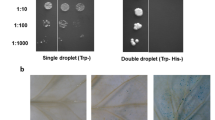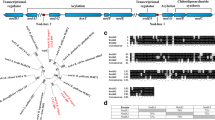Abstract
The VirA protein ofAgrobacterium tumefaciens is thought to be a receptor for plant phenolic compounds such as acetosyringone. Although it is not known whether the interaction between VirA and the phenolics is direct or requires other phenolic-binding proteins, it is shown in this study that the first 280 amino acids of the VirA protein are not essential for the acetosyringone mediatedvir gene induction response. Considering the fact that the cytoplasmic region between the amino acids 283 and 304 is highly conserved between the different VirA proteins, and that deletion of this region abolishes VirA activity, we suggest that the acetosyringone receptor domain is located in this cytoplasmic domain of the VirA protein.
Similar content being viewed by others
References
Ankenbauer RG, Best EA, Palanca CA, Nester EW: Mutants of theAgrobacterium tumefaciens virA gene exhibiting acetosyringone-independent expression of thevir regulon. Mol Plant-Microbe Interact 4: 400–406 (1991).
Beijersbergen A, Den Dulk-Ras A, Schilperoort RA, Hooykaas PJJ: Conjugative transfer by the virulence system ofAgrobacterium tumefaciens. Science 256: 1324–1327 (1992).
Cangelosi GA, Ankenbauer RG, Nester EW: Sugars induce theAgrobacterium tumefaciens virulence genes through a periplasmic binding protein and a transmembrane signal protein. Proc Natl Acad Sci USA 87: 6708–6712 (1990).
Chang C, Winans SC: Functional roles assigned to the periplasmic, linker, and receiver domains of theAgrobacterium tumefaciens VirA protein. J Bact 174: 7033–7039 (1992).
Endoh H, Hirayama T, Aoyama T, Oka A: Characterization of thevirA gene of the agropine-type plasmid pRiA4 ofAgrobacterium rhizogenes. FEBS Lett 271: 28–32 (1990).
Gardina P, Conway C, Kossman M, Manson M: Aspartate and maltose-binding protein interact with adjacent sites in the Tar chemotactic signal transducer ofEscherichia coli. J Bact 174: 1528–1536 (1992).
Hooykaas PJJ, Roobol C, Schilperoort RA: Regulation of the transfer of Ti plasmids ofAgrobacterium tumefaciens. J Gen Microbiol 110: 99–109 (1979).
Huang Y, Morel P, Powell B, Kado CI: VirA, a coregulator of Ti-specified virulence genes, is phosphorylatedin vitro. J Bact 172: 1142–1144 (1990).
Imae Y, Oosawa K, Mizuno T, Kihara M, Macnab R: Phenol: a complex chemoeffector in bacterial chemotaxis. J Bact 169: 371–379 (1987).
Jin S, Prusti RK, Roitsch T, Ankenbauer RG, Nester EW: Phosphorylation of the VirG protein ofAgrobacterium tumefaciens by the autophosphorylated VirA protein: essential role in biological activity of VirG. J Bact 172: 4945–4950 (1990).
Jin S, Roitsch T, Ankenbauer RG, Gordon MP, Nester EW: The VirA protein ofAgrobacterium tumefaciens is autophosphorylated and is essential forvir gene regulation. J Bact 172: 525–530 (1990).
Jin S, Roitsch T, Christie PJ, Nester EW: The regulatory VirG protein specifically binds to acis-acting regulatory sequence involved in transcriptional activation ofAgrobacterium tumefaciens virulence genes. J Bact 172: 531–537 (1990).
Kunkel TA, Roberts JD, Zakour RA: Rapid and efficient site-specific mutagenesis without phenotypic selection. Meth Enzymol 154: 367–382 (1987).
Lee K, Dudley MW, Hess KM, Lynn DG, Joerger RD, Binns AN: Mechanism of activation ofAgrobacterium virulence genes: identification of phenol-binding proteins. Proc Natl Acad Sci USA 89: 8666–8670 (1992).
Leroux B, Yanofsky MF, Winans SC, Ward JE, Ziegler SF, Nester EW: Characterization of thevirA locus ofAgrobacterium tumefaciens: a transcriptional regulator and host range determinant. EMBO J 6: 849–856 (1987).
Lynch BA, Koshland DE: disulfide cross-linking studies of the transmembrane regions of the aspartate sensory receptor ofEscherichia coli. Proc Natl Acad Sci USA 88: 10402–10406 (1991).
Mattanovich D, Rüker F, da Câmara Machado A, Laimer M, Regner F, Steinkellner H, Himmler G, Katinger H: Efficient transformation ofAgrobacterium spp. by electroporation. Nucl Acids Res 17: 6747 (1989).
Melchers LS, Thompson DV, Idler KB, Neuteboom STC, de Maagd RA, Schilperoort RA, Hooykaas PJJ: Molecular characterization of the virulence genevirA of theAgrobacterium tumefaciens octopine Ti plasmid. Plant Mol Biol 9: 635–645 (1987).
Melchers LS, Regensburg-Tuïnk TJG, Bourret RB, Sedee NJA, Schilperoort RA, Hooykaas PJJ: Membrane topology and functional analysis of the sensory protein VirA ofAgrobacterium tumefaciens. EMBO J 8: 1919–1925 (1989).
Miller JH: Experiments in Molecular Genetics. Cold Spring Harbor Laboratory Press, Cold Spring Harbor, NY (1972).
Milligan DL, Koshland DE: Site-directed cross-linking: establishing the dimeric structure of the aspartate receptor of bacterial chemotaxis. J Biol Chem 263: 6268–6275 (1988).
Morel P, Powell BS, Rogowsky PM, Kado CI: Characterization of thevirA virulence gene of the nopaline plasmid, pTiC58, ofAgrobacterium tumefaciens. Mol Microbiol 3: 1237–1246 (1989).
Oosawa K, Simon M: Analysis of mutations in the transmembrane region of the aspartate chemoreceptor inEscherichia coli. Proc Natl Acad Sci USA 83: 6930–6934 (1986).
Parkinson JS, Kofoid EC: Communication modules in bacterial signaling proteins. Annu Rev Genet 26: 71–112 (1992).
Pazour GJ, Das A: Characterization of the VirG binding site ofAgrobacterium tumefaciens. Nucl Acids Res 18: 6909–6913 (1990).
Pazour GJ, Ta CN, Das A: Mutants ofAgrobacterium tumefaciens with elevatedvir gene expression. Proc Natl Acad Sci USA 88: 6941–6945 (1991).
Powell BS, Kado CI: Specific binding of VirG to thevir-box requires a C-terminal domain and exhibits a minimum concentration threshold. Mol Microbiol 4: 2159–2166 (1990).
Sanger F, Nicklen S, Coulson A: DNA sequencing with chain terminating inhibitors. Proc Natl Acad Sci USA 74: 5463–5467 (1977).
Shimoda N, Toyoda-Yamamoto A, Nagamine J, Usami S, Katayama M, Sakagami Y, Machida Y: Control of expression ofAgrobacterium vir genes by synergistic actions of phenolic signal molecules and monosaccharides. Proc Natl Acad Sci USA 87: 6684–6688 (1990).
Turk SCHJ, Melchers LS, den Dulk-Ras H, Regensburg-Tuïnk AJG, Hooykaas PJJ: Environmental conditions differentially affectvir gene induction in differentAgrobacterium strains. Role of the VirA sensor protein. Plant Mol Biol 16: 1051–1059 (1991).
Turk SCHJ, van Lange RP, Sonneveld E, Hooykaas PJJ: The chimeric VirA-Tar receptor protein is locked into a highly responsive state. J Bact 175: 5706–5709 (1993).
Turk SCHJ, Nester EW, Hooykaas PJJ: The VirA promoter is a host-range determinant inAgrobacterium tumefaciens. Mol Microbiol 7: 719–724 (1993).
van Rijn PA, Goosen N, Turk SCHJ, van de Putte P: Regulation of phage Mu repressor transcription by IHF depends on the level of the early transcription. Nucl Acids Res 17: 10203–10212 (1989).
Yanisch-Perron C, Vieira J, Messing J: Improved M13 phage cloning vectors and host strains: nucleotide sequences of the M13 mp 18 and pUC19 vectors. Gene 33: 103–119 (1985).
Author information
Authors and Affiliations
Rights and permissions
About this article
Cite this article
Turk, S.C.H.J., van Lange, R.P., Regensburg-Tuïnk, T.J.G. et al. Localization of the VirA domain involved in acetosyringone-mediatedvir gene induction inAgrobacterium tumefaciens . Plant Mol Biol 25, 899–907 (1994). https://doi.org/10.1007/BF00028884
Received:
Accepted:
Issue Date:
DOI: https://doi.org/10.1007/BF00028884




